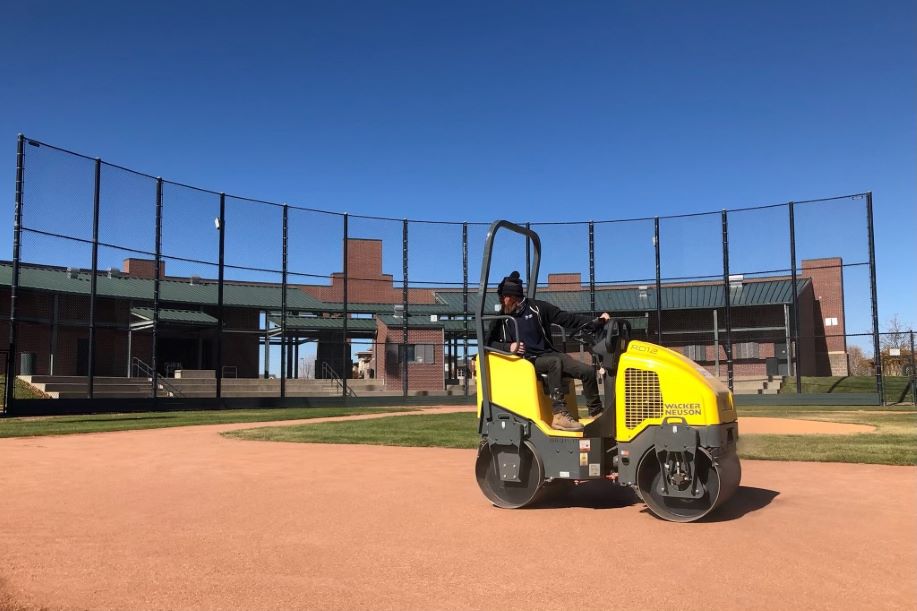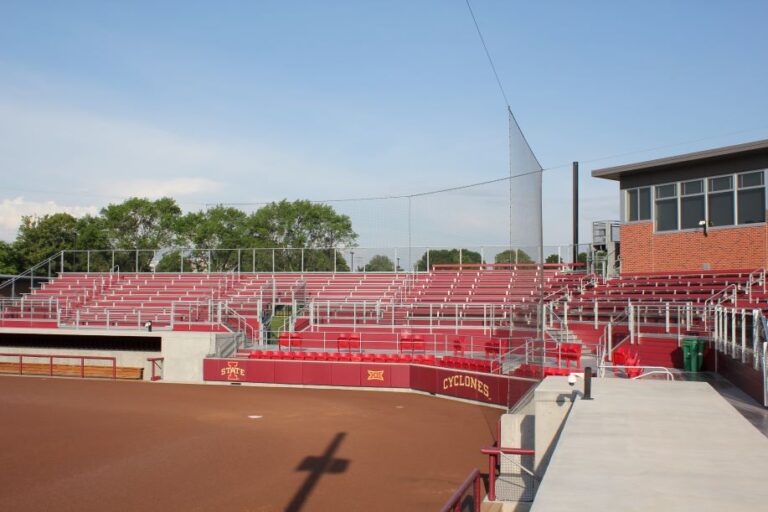By Nick Balistrieri
When deciding to upgrade your baseball or softball facilities, there are a lot of things to consider. It’s easy to accumulate a substantial wish list quickly, so distinguishing between your needs and wants is crucial to maximize your budget. Let’s explore several areas in and around the field where improvements can be made, along with important considerations to keep in mind during this process.
Backstop netting systems
Backstop netting systems will be an improvement both players and fans will appreciate. Removing those bulky and beat up chain-link backstops will give your field a big-league feel, and fans will appreciate the improved sightlines offered by fewer poles and netting. The scuffing balls get when they are constantly fouled off a metal fence doesn’t happen with netting. Typically, you can get 30 to 40 feet in height for less money in netting than a 30- to 40-foot chain link system. We recommend incorporating some sort of knee wall, so the netting doesn’t come straight to the ground. This will help with mitigating damage from maintenance equipment and little critters – increasing the longevity of the net. Those walls can be made of concrete, block or a modular wall system. Certain systems enable easy net removal for extreme weather conditions such as tornadoes, hurricanes or cold winters. Doing so will add extra life to the net. Switching to netting will be the most noticeable improvement you can make, and it will affect the biggest number of people visiting the field.

Barrier netting
Barrier netting is becoming increasingly popular every day at the MLB and MiLB levels. It also is becoming more popular at multiuse/multifield complexes. When determining your needs for barrier netting, first decide what you are trying to protect. It could be protecting a nearby playground or parking lot, or just the people who are too busy on their phones instead of watching their kids play. Either way, selecting the appropriate height will be very important to ensure that nothing bad happens. Like backstops, barrier nets provide good flexibility to go upwards of 40 feet in height and let you span much farther between poles than chain link fences – helping increase sightlines.
Dugouts
Dugouts can be upgraded simply by adding accessories such as a bat/helmet rack or new benches, or by adding padding and netting to the front of your dugout. Any of those items will dress up dugouts and make them more usable for the players. If it is in the budget to do more, there are a few more options from which to choose. Dugouts can be below field grade, or at field grade. Building dugouts below field grade may limit the options or styles of dugouts you can choose. If you don’t go that route, there are several dugout packages that will add a professional look. With dugout packages, pay attention to the structural forces that the dugouts are engineered to absorb. Dugouts can become expensive quickly, so having a clear plan and understanding your needs is crucial to staying within budget.
Batting cages
Outdoor batting cages can provide a nice practice/warm-up facility all season long. The setup can be customized by positioning cages side by side or end to end. There are attachments available for additional hitting stations to make the most of the setup. With any batting cage, it is always recommended to hit and throw from a mat on top of the turf, so as not to wear out those two high-traffic areas.

Windscreen
Windscreen can be a relatively inexpensive way to spruce up fencing or dugouts. Add logos or prints to display school spirit or town colors, or choose a plain design for added privacy and to shield against unwelcome wind. There are different types of windscreen materials to provide more privacy, durability to wind, and color/printing options. If measured and installed correctly, a windscreen can give that extra wow factor to really set your complex apart.
Clay/infield renovations
Clay/Infield renovations are one of the biggest and best improvements you can make to your playing surface. Adding clay to the mound and plate will dramatically affect the quality of both of those areas. Most outs are recorded on the infield or at the plate, so making sure that those surfaces are up to snuff is important. Any dirt/clay improvement should be based on your maintenance capabilities. If you don’t have the staff to maintain clay on a daily or every-other-day basis, we wouldn’t recommend you add clay to the plate or the mound. Luckily, there are other options that will get you closer to the desired result of smaller holes. Using rubber hitting mats in place of clay is an affordable and low-maintenance option. It is hard to hit when standing in a batter’s box and one foot is higher than the other. Same thing for the mound – it is very unsafe to have a crater in your landing spot. Safety should be the priority for every sports field manager.
Just as important as adding clay to the mound and the dish is choosing the right infield mix. The right infield mix will lighten your daily maintenance load significantly compared to maintaining an unbalanced mix. I have had a lot of success with engineered soils in both the amendment process and a full 3- to 4-inch cap. Determining how much clay is in your mix is very important. If you do not have the time or labor to put out water multiple times a day, you should not be using a high clay content in your mix. If you do have the capability to water frequently and have a tarp on hand, then you should use a mix with a higher clay content. Conversely, aim for a silt percentage that’s about half or equal to the amount of clay, maintaining a silt/clay ratio between 0.5 and 1.
By selecting a properly balanced infield mix, you will notice your mix stays in place and doesn’t migrate to different spots on your infield or to your grass. If the mix stays in place and holds its grade, water will run off the infield in the proper direction, which will allow you to get back on the field after rain quicker. It will also help avoid lips on your edges, which can be extremely dangerous when players are trying to field a ground ball and the ball comes up toward their face instead of staying down like it should. Just like when determining to add clay, your maintenance capabilities should determine what you want to do with your infield mix. Adding infield irrigation will dramatically affect your infield’s playability. Most irrigation companies will advise on using a high-speed head to avoid excessive puddling.
Like with all improvements, these things come at a cost. Some are more significant than others. If you don’t have the money readily available, don’t give up. There are multiple avenues to explore to get some help with these items. Consider applying for grants, getting donations from people who have a vested interest in the field or community, and asking associations who use the field to fundraise. Getting buy-in from all parties involved is an important step in getting the upgrades past the finish line.
Any of these improvements will make a difference. Don’t be afraid to reach out to companies who do these things for a living and ask questions about anything you don’t have experience with. As always, reaching out to your peers who may have had experience with improving their own fields will be beneficial. Ensuring we can provide safe facilities and fields will only help in making sure kids keep on playing youth sports so we all can continue to do what we love.
Nick Balistrieri of Beacon Athletics has 13 years of grounds management experience. He has spent time at the MLB, NCAA and parks and rec levels, and has transitioned to the sales side of the industry. He is passionate about working with customers to provide safe playing surfaces and safe facilities for everyone who uses them.


